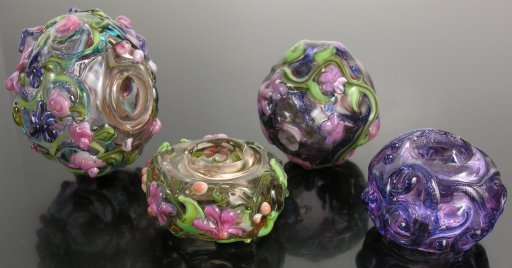There are several conditions that can cause hollow mandrel wound beads to collapse: the artist may lay the coils down unevenly, with gaps; the coils themselves may separate, & gap); or, the beginning coils may not stick firmly enough to the release and/or air may leak through the release. The latter two conditions are exacerbated by uneven heating. Thus, if one lays down coils too slowly, with too-infrequent warming passes, they cool and shrink, voila, gaposis. If the mandrel is insufficiently hot, the glass may stick, but not really bond. With mandrels of 1/8” (3mm) or less, this isn't really an issue; but larger diameter mandrels, even those made of tubing, act as heat sinks.

4 “bighole” beads. Largest, 32x45mm, hole 11mm (7/8”) in diameter. And my goodness, pink Italian soda-lime has a brownish cast.
I get around this in various ways, such as air-drying the release and preheating the mandrels in a kiln. In fact, these beads were made with 3 different types of mandrels. The biggest one, on the left, and (I think) the one to right, were the two made on cross-drilled stainless tubing. This is a technique/tool I learned from Stevi Belle. You drill a hole near the end of your tube, plug the tip of it, and build your mandrel wound hollow like usual—except, you can blow air through the little hole. This is nice when you've let your bead cool too much, and it cracks: you simply heat it, heal it, and puff it back out, with no loss of volume. Thus, this technique is a variation on glass-blowing, but gives the support of a mandrel—the best of both worlds.
The disadvantage is that you must rotate a mandrel 3/8” in diameter.
The other roundish bead, 2nd from the right, was made on a quarter-inch solid mandrel—very heavy! Again, once your wrist gets used to the weight, it's not so bad, but I haven't been making large beads regularly for a long time. Guess I should get serious about learning arm balances.
And finally, we have Arrow Springs’ "Emiko" big-hole mandrels, in which a cylinder is brazed to a nice thick (but not too thick) solid mandrel—this keeps the weight down, the newest incarnation features a highly textured surface to grip the bead release, as well as a rounded tip for folks wanting to make solid vessels.
So far, I'm kinda liking the first option the best, but I'm only 4 beads into this project. It will be interesting to see how it evolves. If nothing else, I might finally start making glass pis, one of my favorite accents back in my stringing days.
pix taken 20aug07; intro written 19aug; post 22aug07; retagged 2jun08.
Unless otherwise noted, text, image and objects depicted therein copyright 1996--present sylvus tarn.
Sylvus Tarn